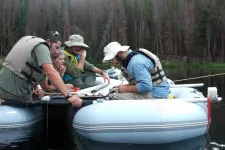(Press-News.org) In many parts of the world, mosquitoes are a common summertime nuisance.
But in places on the front lines of climate change, these disease-spreading insects may one day be a year-round problem, according to new research from the University of Florida.
"In tropical regions, mosquitoes are active all year, but that isn't the case for the rest of the world. Outside of the tropics, winter temperatures cause mosquitoes to go into a kind of hibernation called diapause. We call these mosquitoes 'cold bounded' because their activity is limited by these lower temperatures," said Brett Scheffers, senior author of the study and an assistant professor in the UF/IFAS wildlife ecology and conservation department.
"However, with climate change, we expect summers to get longer and winters to become shorter and warmer. What will that mean for those cold bounded mosquitoes? How will they respond?" Scheffers said.
To help answer those questions, the study's authors conducted experiments with mosquitoes collected in and around Gainesville, a North Central Florida city on the dividing line between subtropical and temperate climates. Their study is published in the journal "Ecology."
The researchers compared how mosquitoes collected during different parts of the year responded to changes in temperature.
"We found that the mosquitoes in our study are what we call 'plastic,' meaning that, like a rubber band, the range of temperatures they can tolerate stretches and contracts at different times of year," Scheffers said.
The researchers found that in the spring, when nighttime temperatures are still cold and daytime temperatures begin to warm up, mosquitoes can tolerate a larger range of temperatures. Come summer, when daily temperatures are warm, that range contracts. In autumn, when temperatures begin to cool off, the range stretches again, Scheffers explained.
"That tells us that as climate change makes our autumns and winters warmer, mosquitoes in more temperate regions are well prepared to be active during those times," Scheffers said.
"Our results suggest that to better understand how well populations and species may be able to tolerate ongoing climate change, we need to measure species thermal responses across different times of the year," said Brunno Oliveira, the study's first author, who conducted the study while a postdoctoral researcher in Scheffers's lab.
"This information would help us to deliver a more accurate representation of the temperature range a species can tolerate," said Oliveira, now a postdoctoral research at University of California Davis.
For their experiment, the researchers collected the mosquitoes at more than 70 sites around Gainesville and the nearby UF/IFAS Ordway-Swisher Biological Station, a 9,500 acre research and conservation area located about 20 miles east of the city.
The scientists lured mosquitoes with special traps that emit carbon dioxide gas, the same gas that humans and animals exhale when we breath. To a mosquito, a strong whiff of carbon dioxide means a meal is nearby.
With these traps, the researchers caught more than 28,000 mosquitoes representing 18 species. From this collection, the scientists randomly sampled about 1,000 mosquitoes to test in the lab.
Each mosquito was placed in a vial that was then put in a water bath. Over time, the researchers changed the water temperature, increasing or decreasing the temperature inside the vials. The scientists monitored each mosquito's activity, noting when mosquitoes became inactive, a signal that either the upper or lower temperature thresholds were met.
"It was surprising to see how well these little creatures could tolerate high temperatures during the experiments, often well above the mean ambient temperatures measured by the weather stations," said Gécica Yogo, one of the study's co-authors.
Yogo helped conduct the study while she was research scholar trainee at UF as part of her master's program at AgroParisTech in France. She is now a soil carbon engineer at INRAE, the French National Institute for Agriculture, Food and Environment.
The researchers say they don't yet know what allows mosquitoes to adjust to rapid changes in temperature.
"Many people do not realize how quickly natural selection can act on short-lived animals," said Daniel Hahn, professor in the UF/IFAS entomology and nematology department and a co-author of the study. "Whether the changes we are seeing in mosquito thermal properties are due to rapid natural selection across seasons, seasonal plasticity - much like a dog changing its coat -- or a combination of both, is what we are working on now."
The researchers say that insights from this study can help communities better prepare for the impacts of climate change as they relate to mosquitoes, which spread diseases that affect humans and animals.
"The more mosquito activity there is, the greater the risk of these diseases spreading. Knowledge is power, and knowing that mosquitoes will be more active for more of the year can inform how we get ready for climate change," Scheffers said.
Peter Jiang, one of the study's co-authors and an entomologist with City of Gainesville's Mosquito Control division, said that residents play an important role in controlling mosquitoes now and in the future.
Simple actions can keep mosquito populations down, Jiang said.
"Neighbors are encouraged to empty, remove or cover any receptacle that would hold water -- particularly old bottles, tin cans, junk and tires -- repairing leaky pipes, outside faucets and screens, covering or turning small boats upside down, and, twice a week, changing water in wading pools, bird baths, pet dishes and vases holding flowers or cuttings," Jiang said.
Residents looking to learn more about how to control mosquitoes can contact their local UF/IFAS Extension office or their municipal or county mosquito control program.
In addition to informing decision-making, studies like this one bring into focus an aspect of climate change now getting more attention.
"When we talk about how climate change might affect plants and animals, we are often talking about species moving to new areas because the conditions are changing -- in other words, the arrival of something new. However, climate change will also affect species we live with right now, like highly flexible mosquitoes, and that's another aspect to consider," Scheffers said.
INFORMATION:
June 14, 2021 - Last fall, the Mullen fire west of Laramie raged for the better part of two months, burning more than 176,000 acres and 70 structures in Wyoming's Carbon and Albany counties, and in Jackson County, Colo.
Unfortunately, this scenario was typical during the intense 2020 fire season in the Rocky Mountain region, an area of Colorado and southern Wyoming where high-elevation forests are burning more than at any point in the past 2,000 years, according to a study in which a University of Wyoming faculty member was instrumental.
"Global warming is causing larger fires in Rocky Mountain forests than have burned for thousands of years," says Bryan Shuman, a professor in the UW Department of Geology and Geophysics. "The last time anything ...
ITHACA, N.Y. - Most sensible air travelers dread turbulence. A little atmospheric hiccup can shake airplanes, rattle nerves and spill beverages. A Cornell University-led study found that birds don't mind at all.
By combining wind speed data with the measured accelerations of a golden eagle outfitted with GPS tracking instruments, the researchers suggest that, rather than hindering flight, turbulence is a source of energy that birds may use to their advantage.
This counterintuitive discovery could revise what we know about avian flight, and help the aerospace industry develop faster, more efficient ways to fly in turbulent environments.
The paper, ...
Pancreatic cancer is an aggressive disease in which malignant cells form in the tissues of the pancreas, a long and flat gland located behind the stomach that helps with digestion and blood sugar regulation. Because pancreatic cancer is difficult to detect early, it is associated with a low survival rate, accounting for just over 3% of all new cancer cases in the U.S., but leading to nearly 8% of all cancer deaths, according to the National Cancer Institute.
Through a pre-clinical study conducted in his former role at Moffitt Cancer Center and published in Clinical Cancer Research, Said Sebti, Ph.D., associate director for basic research at VCU Massey Cancer Center, identified a novel drug that effectively thwarts pancreatic tumors that are addicted ...
Analyzing how people move about in their daily lives has long been important to urban planners, traffic engineers, and others developing new infrastructure projects.
But amid the social restrictions and quarantine policies imposed during the global spread of COVID-19--which is directly linked to the movement of people--human mobility patterns changed dramatically.
To understand just how COVID-19 affected human movement on a global scale, Shouraseni Sen Roy, a professor in the College of Arts and Sciences Department of Geography and Sustainable Development, and graduate student Christopher Chapin developed COVID-19 vs. Human Mobility, an innovative and interactive web application that, shared in a new ...
In polymicrogyria, the cortex of the brain has many irregular, small folds (gyria) and disorganization of its layers. Many affected children have severe developmental delay, intellectual disabilities, and epilepsy, and many need to use a wheelchair. Mutations in several different genes can cause this "overfolding of the brain" condition.
Studying four patients with polymicrogyria, Richard Smith, PhD, identified mutations in a gene that caused him to do a double-take. His curiosity drove him to investigate the role of this gene, called ATP1A3, in the developing brain.
"ATP1A3 is critical to many cell biological processes," says Smith, an investigator the Division of Genetics and Genomics at Boston Children's Hospital. ...
Those who deactivated their Facebook profiles report a lower regard for other ethnic groups, and this effect was more prevalent among people living in more ethnically homogenous areas, shows a new study of users in Bosnia and Herzegovina (BiH). The findings run counter to a commonly held view that social media usage exacerbates societal polarization.
The work, conducted by researchers at New York University's Center for Social Media and Politics (CSMaP), appears in the Proceedings of the National Academy of Sciences (PNAS).
"For all our attention to the online drivers of polarization, we should not forget about the importance of offline factors as well," ...
MISSOULA - Following 2020's extreme fire season, high-elevation forests in the central Rocky Mountains now are burning more than at any point in the past 2,000 years, according to a new University of Montana study set to publish in the Proceedings of the National Academy of Sciences.
Researchers from UM and the University of Wyoming analyzed a unique network of fire-history records to understand how 21st-century fire activity compares to wildfires in the past. The findings highlight that burning in recent decades in high-elevation forests of northern Colorado and southern Wyoming is unprecedented over the past several millennia.
As fire paleoecologists - scientists who study historical ecosystems - the team uses charcoal found in lake sediments to piece together the fire ...
PULLMAN, Wash. - You can take a fish out of toxic water, but its epigenetic mutations will remain for at least two generations.
A research team led by Washington State University scientists analyzed the epigenetics--molecular factors and processes that determine whether genes are turned on or off--of a group of Poecilia mexicana fish, or Atlantic molly, that live in springs naturally high in hydrogen sulfide, which is normally toxic to most organisms.
The researchers removed a sample of fish from the toxic water and bred them in freshwater. They found that the grandchildren of the sulfidic-adapted fish had more epigenetic marks ...
EVANSTON, Ill. --- The human gut is more than a source of instinct.
A new Northwestern University study is the first to explicitly address the gut microbiome as a pathway to understanding how environmental inequities could lead to health disparities.
Biological anthropologist Katherine Amato, assistant professor of anthropology at the Weinberg College of Arts and Sciences at Northwestern, is the study's lead author.
Amato says, despite a rich body of literature documenting environmental impacts on the microbiome, and the microbiome's impact on human health, ...
International team used the stomach bacteria Helicobacter pylori as a biomarker for ancient human migrations
DNA sequences catalogued at University of Warwick in EnteroBase, a public genomes database, demonstrate that a migration of Siberians to the Americas occurred approximately 12,000 years ago
Project began in 2000s but new statistical techniques allowed researchers to reconstruct and date the migrations of Siberian Helicobacter pylori
Early migrations of humans to the Americas from Siberia around 12,000 years ago have been traced using the bacteria they carried by an international team including scientists at the University of ...



